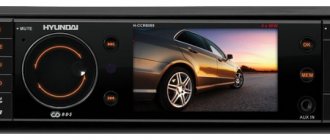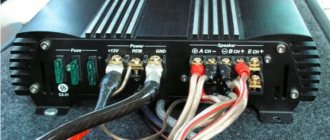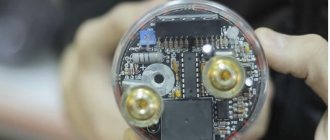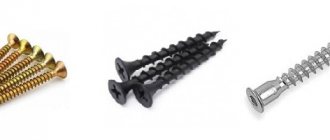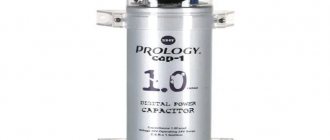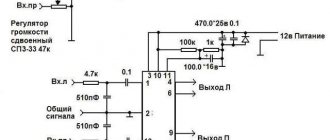Most modern subwoofer speakers are equipped with two coils. Connecting the subwoofer 2 2 is carried out in two ways, depending on which you can get different resistance. The smaller it is, the more power the amplifier will deliver.
In this article we will tell you about switching circuits and explain how serial and parallel methods differ, and also talk about the characteristics of amplifiers, since not all of them can operate stably in a low-impedance load.
We also recommend that you read the article “how to connect an amplifier for a subwoofer”, in it you will find a connection diagram and recommendations for selecting power and signal wires.
Subs with one coil 2 and 4 Ohm
1 sub with two and one 4 ohm coils
1 sub with two 2 ohm coils
3 subwoofers with two and one 4 ohm coils
4 subwoofers with two 4 ohm coils
3 subwoofers with two 2 ohm coils
4 subwoofers with two 4 ohm coils
4 subwoofers with two coils of 2 ohms, resistance 1 ohm
4 subwoofers with two 2 ohm coils
4 subwoofers with two 4 ohm coils
4 subwoofers with one 8 ohm coil
2 subwoofers with one 8 ohm coil
admin
Comments 70
Where do you get the plus minus when connecting 3 subs with one coil?
And so the question is, I didn’t find a diagram for you, a custom sub former Def Bons 123, the coils were converted to 0.50.5 ohm resistance, monoblock machete m2000d, how to connect
it in one ohm? A diagram, at least in words. I would be very happy, I’m afraid I’ll burn it, it’s a little expensive.
There is a Mystery MO12S two-reel sub, not a monoblock MR1.300, also a Mystery. What is the circuit for it so that it works from a two ohm amplifier? If I understand correctly, then according to the ten scheme?
author, excuse me, but parallel switching of a subwoofer with two coils is four ohms, isn't there any ohm? After all, they divide and then meet, it turns out 4_4 = 1 Ohm. Am I wrong otherwise?
How to connect a monoblock in 1 ohm
It may be easier to connect a single-coil subwoofer to a monoblock or multi-channel amplifier. It's a completely different matter if the subwoofer has two voice coils or two or more of them.
A two-coil subwoofer, as well as two, three or more subwoofers, can be connected in four ways: each coil separately, parallel connection of coils, serial and combined.
What each of these subwoofer switching options gives is, first of all, versatility, different capabilities. Let's consider each option separately. But first of all, you need to understand what happens when the coils are connected in parallel or in series.
When the coils are connected in parallel, the total resistance, roughly speaking, becomes half as much. For example: if we connect two 4 Ohm coils in parallel, we get a total resistance of 2 Ohms, if we connect two 2 Ohm coils, we get a total resistance of 1 Ohm.
The opposite effect occurs with a series connection. When connecting two 4 Ohm coils in series, we get a resistance of 8 Ohms, when connecting two 2 Ohm coils, we get 4 Ohms. etc.
Connecting each coil separately . This option allows you to connect a powerful two-coil subwoofer to a less powerful four-channel amplifier if it is not possible or not possible to purchase a powerful monoblock. Naturally, the resistance of the coils must correspond to the operating load of the amplifier in a bridge connection and the GAIN controls must be at the same level.
Parallel connection of coils - subwoofers.
As described above, when connected in parallel, the resistance is halved, allowing the amplifier, operating at a lower load, to deliver more power.
But as they say, “if it leaves somewhere, it will definitely arrive somewhere.” In this case, this is true, only on the contrary, the power has increased, and the amplifier’s control over the subwoofer has decreased, as a result of which the bass becomes smeared.
Series connection of coils . If the amplifier is powerful, why not, increase the impedance (resistance) and get a more developed bass.
I would also like to add that if the resistance of the connected coils exceeds the permissible load of the amplifier, this is not at all scary, it’s just that the output power of the amplifier will be less.
Let's say an amplifier with a declared operation for a load of 4 ohms produces 500 watts, and with a load of 8 ohms, for example, it will produce 350 watts.
Combined connection . Subwoofers are coils that are simultaneously connected in serial and parallel connections for switching to a specific load. There are a great many connection options, it all depends on the number of subwoofer speakers, the resistance of the subwoofer voice coils and the capabilities of the amplifier.
“Every little one knows, black is a minus, red is a plus!”
Connecting the subwoofer to the radio
It is necessary to connect the subwoofer to the radio only through an amplifier. Since the built-in power of the radio is not enough for the subwoofer to work properly, you will not get normal bass. The connection chain is simple: radio-amplifier-subwoofer. The radio transmits the signal to the amplifier. The amplifier, in turn, amplifies this signal and sends it to the subwoofer.
What is an amplifier for?
The amplifier is used to increase the volume headroom, reduce distortion and improve the sound quality of music. The built-in amplifier of the radio is not enough to drive a heavy low-frequency speaker, which will cause large distortions, the volume level will be low and, with a high probability, the subwoofer may fail or simply “burn out.”
If you have an active subwoofer, then you will not need an additional amplifier, because it is already built into the subwoofer housing (more about active subwoofers). For a passive subwoofer you will have to choose an amplifier (read how to do this correctly on this page).
How to connect a subwoofer to an amplifier
Single channel connection
Connecting a subwoofer to an amplifier is not difficult; just connect the amplifier's audio output jack to the subwoofer coil or coils using speaker wires.
The wires should not be thin. In most cases, choose copper wiring with a cross-section of 4 mm and there will be no problems.
Connecting speaker wires
This subwoofer connection diagram is suitable for one channel of an amplifier or monoblock.
Monoblock is a single-channel amplifier designed specifically for subwoofers.
Connecting to a subwoofer via terminal block
Setting up the car's multimedia system
Connecting to a subwoofer directly
Connecting a subwoofer with a bridge
- In the case of using a multi-channel amplifier, the sub can be connected to two channels simultaneously, using the minus of one and the plus of the other, this connection is called bridged, with this method the power output by the amplifier increases significantly (see the specifications for specific numbers).
- So you can connect a subwoofer to a two or four channel amplifier, using 2 channels for acoustics, and the remaining 2 for the subwoofer.
- To connect a subwoofer with a bridge, make sure that your amplifier supports this feature.
- If you connect a low-frequency speaker to an amplifier by changing the polarity, that is, connect the plus of the subwoofer to the minus of the amplifier output and vice versa, then the speaker will work in antiphase, there is nothing wrong with that, sometimes such a connection is used intentionally if the amplifier does not have phase adjustment (more about adjustment phases).
Connecting the subwoofer coils
The technical documentation for the subwoofer states the resistance of its coils (1 Ohm, 2 Ohm, 4 Ohm, rarely 0.
5 Ohms), and the technical documentation of the amplifier indicates what resistances it can work with; this information is needed so that you correctly and effectively connect the subwoofer to the amplifier.
The lower the resistance of the sub, the more power the amplifier will produce, provided that it can operate at this resistance. A subwoofer speaker may have several coils (1 or 2, rarely 4).
When the coils are connected in series, the resistance increases, while in parallel it decreases. If you don't want to learn definitions and count fractions, just save this cheat sheet (parallel and serial connections).
How much ohm to connect the subwoofer
The higher the resistance, the better the sound quality; the lower, the more power the amplifier delivers. If you need a lot of loud bass, then turn it to the minimum that the amplifier can provide, and if the overall sound quality of the system comes first, then it is 2 Ohms or 4 Ohms, depending on the power output.
Video on how to connect 2 subwoofers or more. Subwoofer connection diagram 2x2 Ohm, 4x4 Ohm, 1x1 Ohm. Serial connection of speakers. Parallel connection of speakers. Basic principles.
- Happy connections!
- I decided to post some subwoofer connection diagrams... someone might need it...
see also
see also
Comments 72
Is it possible to connect CT 12 (2+2) at 2 Ohms to Zeus 1.1000 (has 2 pairs of terminals, but it is not known whether they are duplicated or independent)? Thank you
Hello guys everyone. Can you give me some advice too? Amplifier kick rts 4.60 (4 ohm) sub oris two pancakes (1 ohm) two coils. How can I connect a sub so that it hits 4 ohms? Four fronts are connected to the same front. Maybe it’s easier to install an additional amp or wire up the sub itself? I hope I described it in as much detail as possible
Where do you get the plus minus when connecting 3 subs with one coil?
And so the question is, I didn’t find a diagram for myself, the sub is a custom former def bonus 123, the coils have been converted to 0.5+0.5 ohm resistance, the m2000d monoblock machete, how to connect it to 1 ohm? A diagram, at least in words. I would be very happy, I’m afraid I’ll burn it, it’s a little expensive.
There is a two-reel Mystery MO12S sub and a monoblock MR1.300, also a Mystery. What is the circuit for it so that it works from a 2 ohm amplifier? If I understand correctly, then according to scheme 10?
author, of course I’m sorry, but parallel switching of one subwoofer with two 4 ohm coils, wouldn’t it be 1 ohm? After all, they divide, that is, it turns out 4_4 = 1 Ohm. Or am I wrong?
Not right. With series -4+4=8 Ohms With parallel - 1/R total R total= 1/4+1/4, therefore 1/(1/4+1/4) = 1/0.5=2 Ohms. Everything is simple, if there is 1 sub with 4 ohm coils it is only either in 8 or 2, if it is 2 ohms - in 4 or 1 ohm.
blah, Thank you, now everything has fallen into place. I felt ashamed, I was trained as an electrician and didn’t understand how to connect the coils. PPC
bookmarked)))useful, but... I’m a beginner sound engineer, so I have a question. How will it be correct to connect the alphard machete m15d2 (coils 2+2) to the Kixar 1.350 (2 Ohm: 600 W x 1, 4 Ohm: 350 W x 1)?
I will be very grateful for your answer)))
How to connect a sub with a double coil 4+4 in 4 Ohm using both coils?
Greetings, please tell me if I understood correctly how to connect the sub, the monoblock amplifier has 4 terminals - 2 plus, 2 minus, on the sub there are 2 coils of 2 ohms. I connect one plus and minus from the amp to one coil of the subwoofer, the second plus and minus to the second coil and it turns out to be connected in 1 ohm?
Please tell me. How to connect in 1st? Sub Ural Armada 2+2 coils.
one sub 2+2 and 4 channels, will there be any losses when connecting?
Hello everyone, please tell me how to connect 3 subwoofers with 4+4 coils, and how many ohms will be the result?
Hello. Is it possible to connect a 2-channel amplifier with one channel to the sub and the other to the rear speakers?
Maybe. But here is another question: the power of one channel for driving the subwoofer is negligible and the remaining one channel to the rear will be MONO. There is no point in such a connection at all.
Hi all. Tell me sub macheta 15d4. Two coils 4+4 Ohm. how to connect it to a monoblock for stronger pressure. I haven't purchased a monoblock yet. And what kind of candy bar can be connected to it (budget)
Circuit #12 Will work at 2 ohms.
Guys, I have an Alphard Hannibal SD 152 and a Kicx AR 1.350, you can feed it in 1, 2, and 4 and nothing will happen to it, as I understand it? So the sub is rated at 350W, when connected in the 4th ohm it gives 350W, and in the 1st ohm it gives 1000W, and the sub has a peak of 1000W. If I connect it in the 1st ohm, can it be covered? And what is the best way to connect it?
I don’t understand something, should I answer or what?
I don't know what to answer. there will be no pressure in the 8th. in your case, the most successful connection is through a monoblock at 2 ohms. It is much easier to burn a sub with a lack of power than with too much power. What you wrote is that you are trying to make a system not according to your mind, but to cobble together it from what is available. Nothing will come of this traveler's approach. There are amplifications that are not designed for 2 ohms, but in practice I feel very good at 2 ohms. for example kick cap 29.
Well, it would be like that right away, thanks for the answer, but it’s over, I knew it, just as you said, I wanted to create something from what I had, at least it would be a little bit of use from what I wrote if there was a stupid 2 ohm resistor to 2 ohms for screwing up? I’m interested in this... this is for the sake of an experiment for a while, then I’ll take the sub at 4 ohms exactly
theoretically it will work. but I don’t know how it will work in practice. I've never tried to connect like this. Here, only through experimentation will it be possible to find out anything.
I understand, it’s just damn it and I can’t really google exactly my question, it turns out that it’s not at all what I need))
I would still try to connect it to two channels at 2 ohms. Quite often it works fine. But the possibility of burning the amplifier still remains.
I have a 2-channel weak 60-watt nominal, but I have a 4-channel which with a 2-ohm bridge will produce about 600 watts nominal, they write on the internet that it seems like I can handle it, and even if something happens, it should go into defense
I am tormented by a question, I have a 4+4 ohm two-coil din, that is, I can either use 8 ohms or 2 ohms, can I connect it to 2 ohms plus through a 2 ohm resistor to get 4 ohms resistance? Will there be any pressure more than 8 ohms with such a circuit? I’m asking this because I’m afraid to burn out the sub in 2ohm, and the bridge I sat on is not intended to play in 2ohm.
1 sub coil 1+1 how to connect it in 2 ohm?
sequentially: minus and plus among themselves, others minus and plus to the amplifier
hi, is it that it turns out that one coil will just work? I don’t understand? Can you draw a diagram on a piece of paper that is clearer?
Look at diagram No. 4 and connect it the same way.
Already done, thanks for responding buddy!
hi, is it that it turns out that one coil will just work? I don’t understand? Can you draw a diagram on a piece of paper that is clearer?
or according to scheme No. 9
added to bookmarks)
Please tell me a diagram of how to connect two subwoofers, but the only problem is that they have different resistances. one has 2x4 ohms and the second has 2x2 ohms. Is it possible to connect in 1 Ohm?
tell me what the difference is if one sub with two 4 ohm coils plays at 8 ohm or at 2 ohm, what will be the difference?
How to connect a subwoofer in a car
“Every little one knows, black is a minus, red is a plus!”
Connecting the subwoofer to the radio
It is necessary to connect the subwoofer to the radio only through an amplifier. Since the built-in power of the radio is not enough for the subwoofer to work properly, you will not get normal bass. The connection chain is simple: radio-amplifier-subwoofer. The radio transmits the signal to the amplifier. The amplifier, in turn, amplifies this signal and sends it to the subwoofer.
What is an amplifier for?
The amplifier is used to increase the volume headroom, reduce distortion and improve the sound quality of music. The built-in amplifier of the radio is not enough to drive a heavy low-frequency speaker, which will cause large distortions, the volume level will be low and, with a high probability, the subwoofer may fail or simply “burn out.”
If you have an active subwoofer, then you will not need an additional amplifier, because it is already built into the subwoofer housing (more about active subwoofers). For a passive subwoofer you will have to choose an amplifier (read how to do this correctly on this page).
How to connect a subwoofer to an amplifier
Single channel connection
Connecting a subwoofer to an amplifier is not difficult; just connect the amplifier's audio output jack to the subwoofer coil or coils using speaker wires.
The wires should not be thin. In most cases, choose copper wiring with a cross-section of 4.2 square meters. mm and there will be no problems.
Connecting speaker wires
This subwoofer connection diagram is suitable for one channel of an amplifier or monoblock. If a 1-channel amplifier has two pluses and minuses, then don’t get lost, these pairs are simply paralleled for ease of switching. And it makes no difference which of the pluses and minuses the corresponding wire is connected to.
Monoblock is a single-channel amplifier designed specifically for subwoofers.
Connecting to a subwoofer via a terminal block Connecting to a subwoofer directly
Connecting a subwoofer with a bridge
- In the case of using a multi-channel amplifier, the sub can be connected to two channels simultaneously, using the minus of one and the plus of the other, this connection is called bridged, with this method the power output by the amplifier increases significantly (see the specifications for specific numbers).
- So you can connect a subwoofer to a two or four channel amplifier, using 2 channels for acoustics, and the remaining 2 for the subwoofer.
- To connect a subwoofer with a bridge, make sure that your amplifier supports this feature.
- If you connect a low-frequency speaker to an amplifier by changing the polarity, that is, connect the plus of the subwoofer to the minus of the amplifier output and vice versa, then the speaker will work in antiphase, there is nothing wrong with that, sometimes such a connection is used intentionally if the amplifier does not have phase adjustment (more about adjustment phases).
Connecting the subwoofer coils
The technical documentation for the subwoofer states the resistance of its coils (1 Ohm, 2 Ohm, 4 Ohm, rarely 0.
5 Ohms), and the technical documentation of the amplifier indicates what resistances it can work with; this information is needed so that you correctly and effectively connect the subwoofer to the amplifier.
The lower the resistance of the sub, the more power the amplifier will produce, provided that it can operate at this resistance. A subwoofer speaker may have several coils (1 or 2, rarely 4).
When the coils are connected in series, the resistance increases, while in parallel it decreases. If you don't want to learn definitions and count fractions, just save this cheat sheet (parallel and serial connections).
Connection options
How many ohms should I connect the subwoofer to?
The higher the resistance, the better the sound quality; the lower, the more power the amplifier delivers. If you need a lot of loud bass, then turn it to the minimum that the amplifier can provide, and if the overall sound quality of the system comes first, then it is 2 Ohms or 4 Ohms, depending on the power output.
Video on how to connect 2 subwoofers or more. Subwoofer connection diagram 2x2 Ohm, 4x4 Ohm, 1x1 Ohm. Serial connection of speakers. Parallel connection of speakers. Basic principles.
Happy connections!
Where to install
For some motorists, installing acoustic equipment can be a big problem. The matter concerns both the size of the device itself and the car model.
Hatchback and minivan. In cars with this type of body, you can easily find space even to accommodate a large system. This is explained by the good trunk capacity.
Sedans. The trunk in sedans has a smaller volume, so there is not always room there to install a subwoofer. The problem can be solved by installing speakers in the armrests or on the rear shelf.
Cabriolet. In such a body, it is most difficult to connect a subwoofer to the car, since space is at a premium here. In this case, it is better to choose bandpass type acoustics or FC cabinets equipped with a bass reflex.
Methods for connecting subwoofers | Useful car audio
June 17, 2019
// Useful car audio
One of the most important components in audio systems is the subwoofer.
A subwoofer is a speaker designed to reproduce low frequencies that are at the lower sensitivity threshold of the human ear. The term "Subwoofer" is used to describe a system with a low-frequency driver housed in a separate housing.
Terminology
- Maximum sound pressure. Maximum subwoofer volume.
- Frequency range (Hz). The frequency range of the subwoofer can be divided into the area of deep bass 20-40 Hz, medium bass 40-80 Hz, high bass (midbass) 80-160 Hz.
- Sensitivity (dB). The more sensitive the dynamics, the less the amplifier is loaded, the greater the sound pressure it produces at the same power.
- The larger the diffuser size, and therefore the area, the more powerful the bass.
Connecting a subwoofer
Proper connection of a subwoofer with two coils is very important, especially when the amplifier is not capable of operating in a low-impedance load or is too powerful in relation to the speaker. Do not expose the amplifier to loads lower than those permitted by the manufacturer.
The table below shows the connection resistance options.
Connection methods
Parallel connection of speakers Series connection of speakers
| Methods for connecting subwoofers | |||
| Number of speakers | Voice coil | Total impedance | Connection diagram |
| 1 speaker | 4+4 Ohm | 2 ohm | |
| 2+2 Ohm | 1 ohm | ||
| 1+1 Ohm | 0.5 Ohm | ||
| 2 speakers | 4+4 Ohm | 1 ohm | |
| 2+2 Ohm | 0.5 Ohm | ||
| 1+1 Ohm | 0.25 Ohm | ||
| 1 speaker | 4+4 Ohm | 8 ohm | |
| 2+2 Ohm | 4 ohm | ||
| 1+1 Ohm | 2 ohm | ||
| 2 speakers | 4+4 Ohm | 4 ohm | |
| 2+2 Ohm | 2 ohm | ||
| 1+1 Ohm | 1 ohm |
Selection of cables and wires
The wires for the speaker system in the car are multi-core cables that transmit sound signals from the head unit or amplifier to the subwoofer. They play no less important role than the equipment itself. However, choosing the right option is not always easy. The cables presented in specialized stores differ in cross-section, core material, insulation and cost.
According to their purpose, cables for car audio come in 2 types:
- acoustic (such products are required to transmit a signal from the amplifier to the speakers);
- interconnect (they are needed to transport low-voltage signals from the radio to the amplifier).
The first piece of advice that professionals recommend following concerns the price category of the product. Thus, a cheap cable for connecting a subwoofer should not be purchased for expensive equipment, since the quality of the reproduced sound will deteriorate. At the same time, buying expensive wires for budget acoustics will be a waste of money.
Depending on the core material, wire sets come in several types:
- Copper. They, in turn, are divided into those made of rough copper and oxygen-free copper (OFC). In the first case, the products are basic and have a relatively low price. The base made of oxygen-free copper allows you to increase the conductivity of the cable, but the cost of the product will be an order of magnitude higher. Another copper wire is PCOCC, in which the base is made of pure copper.
- Copper-plated aluminum. This is another inexpensive wire option. Among the list of disadvantages of such a product, professionals name increased fragility and brittleness.
- Silver plated or silver. Such products for connecting a subwoofer to a receiver have high performance and durability, but are much more expensive.
Amplifier power
It is taken directly from the car battery terminals. Other power connection options are undesirable, as they will lead to unstable operation of the bridge amplifier and other devices powered from the same circuit.
If the generator and battery cannot handle the high power demand, then power shortages will occur. The lights will blink when listening to music at high volume. A larger battery and a more powerful generator should be installed to ensure proper power levels.
Connecting an active subwoofer through the rear speakers
In a car, the main sound comes through the front speaker systems. Rear speakers are additional, so a low-frequency device is often connected to them. Connecting a subwoofer through the rear speakers ensures normal reproduction of bass frequencies, without the need for an additional amplifier. Connecting a subwoofer from the rear speakers depends on the design of the device. There are two terminals on the rear panel of the passive low frequency system. This is the plus and minus of the woofer. These terminals are connected by speaker cable to the corresponding terminals of the rear speakers of the car. The low-frequency system is connected by a bridge to the plus and minus of different channels of the amplifier, as shown in the figure. The cross-section of the copper stranded wire should be as large as possible, as this reduces resistance and losses during signal transmission. The subwoofer is connected through the rear speakers using a cable from 2.5 to 4.0 mm2.
Four main types
The main types of subwoofers are:
- open;
- hull;
- active;
- passive.
An open subwoofer is the first option. It needs to be built into any of the car panels. This is a smart option for anyone who doesn't like to fiddle around for too long. There is a second option - case-based. It will have to be built into a special box. The calculation here must be accurate. This box increases the sound pressure on the speaker. The speakers are 100% engaged. With its help you can slightly adjust the sound.
There is also a distinction between passive and active. Passive is simple. It lacks an amplifier and crossover. It must be connected in parallel with other speakers. You can make a crossover yourself and include it in the system. But it’s easier to immediately install an active subwoofer, which has both an amplifier and a crossover. Connecting an active subwoofer to your car will solve many problems at once.
In addition, a passive subwoofer sometimes causes a quieter sound from the speaker system, which must be taken into account when making a decision. Active will give good volume. An amplifier and crossover simplify the wiring diagram. It is easier to install an active subwoofer with your own hands without experience, although some may disagree with this point of view.
The amplifier and crossover are important elements. Think about the available options, compare them with the final goal, which is drawn in the mind - rationally. If there is no time or desire to choose or think, in the worst case, an extra part may appear in stock, which is also not a disaster. The supplier or seller, alas, is not obliged to accept back the purchased item if there is no receipt, damage appears, and so on. The money spent could have been invested in something else, but you can always sell speakers, microphones, subwoofers to someone who really needs them. This will allow you to return most of the amount.
Forum "Auto-HiFi"
Here you can see how to correctly connect www. Us Kex 1. Yes, nothing complicated, they correctly advised you to take a normal power cable, install a good battery, don’t turn on the sub all the way for the first time and change the amplifier over time. We advise you to think about the KG35 wire, at least for the sub from the battery, otherwise you may get burned in the cabin!
By Jandarm, November 24, in General questions. On the amp itself there is insane rock art, either 1 ohm minimum for all holes, or only for the two outermost ones.
Grounding
This point is of great importance for the reliable operation of an amplifier connected in bridge mode. The ground connection can be made directly at the installation site of the device. To do this, take a short piece of thick insulated wire. A common bare braided cable will do.
One end of the wire is connected to the negative terminal of the car amplifier, and the other is inserted between the bracket or bar securing the device and the floor of the body.
After this, the connection point is treated with WD-40 to increase reliability and protect against corrosion, and the nut or bolt is tightened.
To avoid interference in the speakers, the body of the device should not be allowed to come into contact with the body of the car. Otherwise, ground loops will form, which will lead to unpleasant interference. To isolate the housing from the car body, you can place a strip of rubber under the mounting bracket.
